Intel Rocket Lake (14nm) Review: Core i9-11900K, Core i7-11700K, and Core i5-11600K
by Dr. Ian Cutress on March 30, 2021 10:03 AM EST- Posted in
- CPUs
- Intel
- LGA1200
- 11th Gen
- Rocket Lake
- Z590
- B560
- Core i9-11900K
Gaming Tests: Red Dead Redemption 2
It’s great to have another Rockstar benchmark in the mix, and the launch of Red Dead Redemption 2 (RDR2) on the PC gives us a chance to do that. Building on the success of the original RDR, the second incarnation came to Steam in December 2019 having been released on consoles first. The PC version takes the open-world cowboy genre into the start of the modern age, with a wide array of impressive graphics and features that are eerily close to reality.
For RDR2, Rockstar kept the same benchmark philosophy as with Grand Theft Auto V, with the benchmark consisting of several cut scenes with different weather and lighting effects, with a final scene focusing on an on-rails environment, only this time with mugging a shop leading to a shootout on horseback before riding over a bridge into the great unknown. Luckily most of the command line options from GTA V are present here, and the game also supports resolution scaling. We have the following tests:
- 384p Minimum, 1440p Minimum, 8K Minimum, 1080p Max
For that 8K setting, I originally thought I had the settings file at 4K and 1.0x scaling, but it was actually set at 2.0x giving that 8K. For the sake of it, I decided to keep the 8K settings.
For our results, we run through each resolution and setting configuration for a minimum of 10 minutes, before averaging and parsing the frame time data.
| AnandTech | Low Resolution Low Quality |
Medium Resolution Low Quality |
High Resolution Low Quality |
Medium Resolution Max Quality |
| Average FPS | 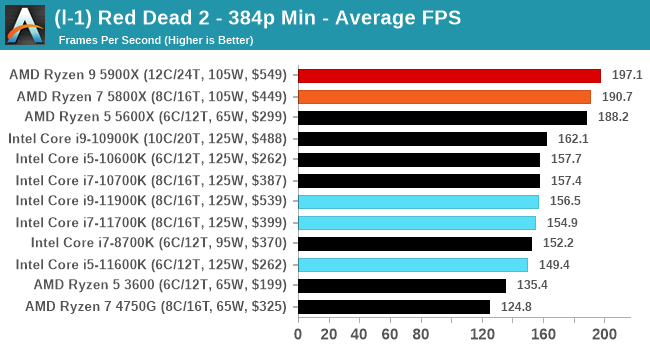 |
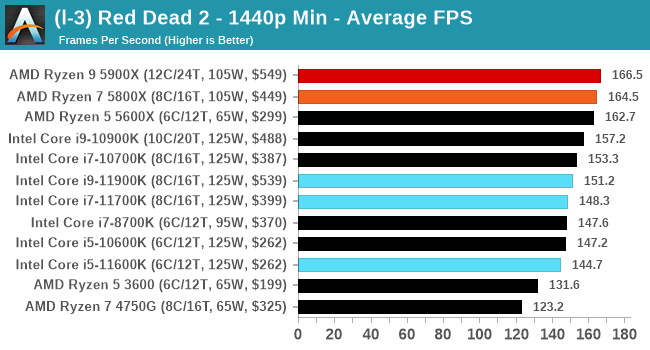 |
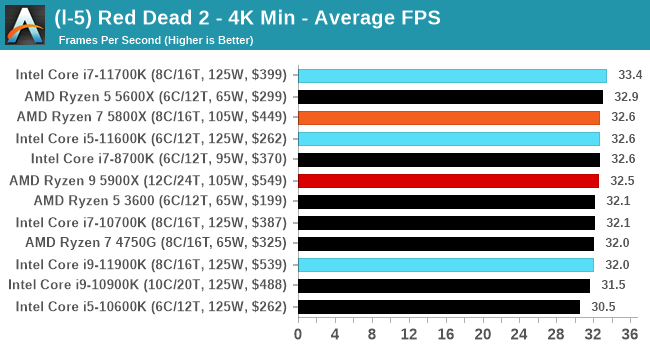 |
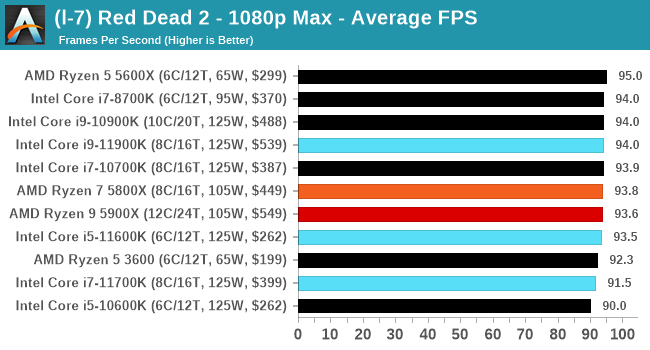 |
| 95th Percentile | 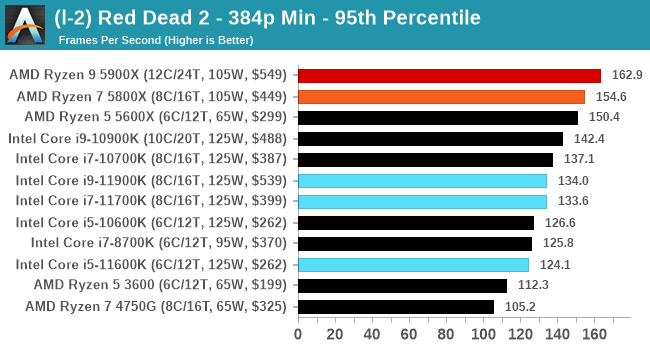 |
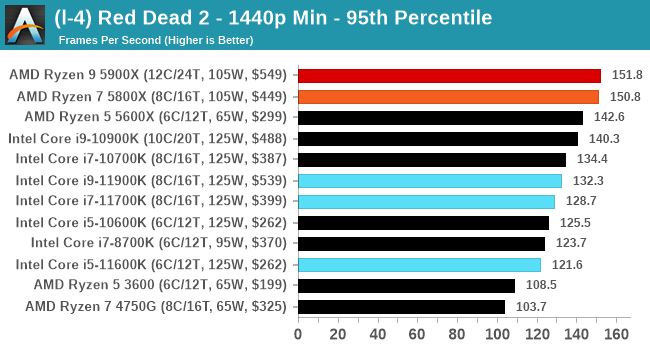 |
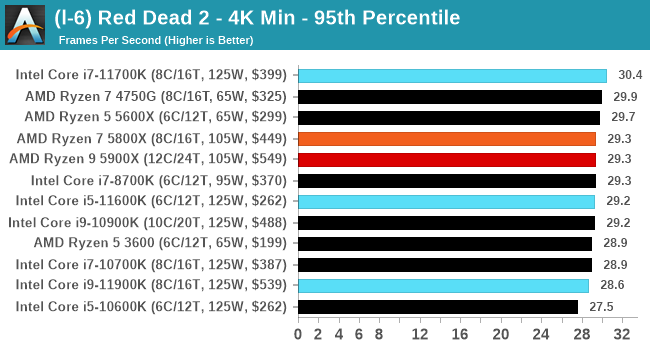 |
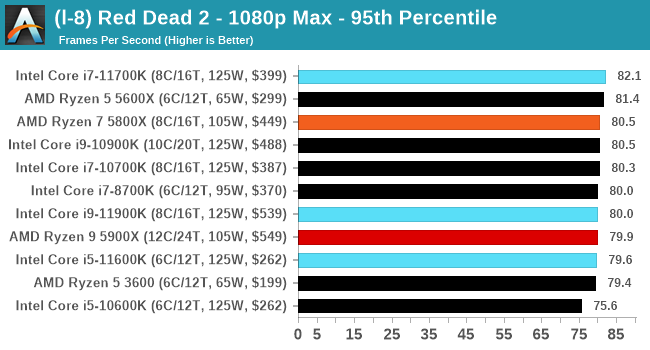 |
All of our benchmark results can also be found in our benchmark engine, Bench.












279 Comments
View All Comments
schujj07 - Wednesday, March 31, 2021 - link
Intel 10nm is not TSMC 7nm.watzupken - Wednesday, March 31, 2021 - link
"What the he'll is that supposed to mean that you can't you can't get the frequency at 10 nm and therefore you have to stick with the 14 nm node? That's pure nonsense, AND is at 7 nm and they are getting the target frequencies. Maybe stop spreading the Coolaid and call a spade a spade...."I am not sure how true this is, but the clockspeed for early versions of 10nm were abysmal. If you look at the first gen of 10nm chip from Intel, Cannon Lake, not just is clockspeed low, but specs is bad. Second gen 10nm, Ice Lake, and you see similar trend of very low clockspeed. I am using an i5 Ice Lake U that is advertised with a base clock of 1Ghz. It is only with 10nm Super Fin (third gen) where you start seeing higher clockspeed. Also, yield with early 10nm is certainly an issue, or they will not have to push out Rocket Lake @ 14nm, while laptops and servers/ workstations (only recently) are on 10nm. I suspect Intel is pushing their 10nm towards the same path as their current 14nm, feed it with more power and push clockspeed as high as possible. I will not be surprise that Alder Lake may bring better performance with a max of 8 big cores, but power consumption wise may only see marginal improvements at load. Light load may not expose the power inefficiency because of the small cores will pick up the load.
boozed - Tuesday, March 30, 2021 - link
There's some weirdness going on in at least one, possibly two of the FFXV 95th percentile graphswatzupken - Wednesday, March 31, 2021 - link
I feel I have to give Intel the credit of moving forward with a 14nm Rocket Lake, instead of hanging around like they did for the last 5 years with the same Skylake chip but boosted with steroids. But evidently, 14nm is becoming a burden to their progress. I know Intel supporters will claim that 14nm is capable of competing with 7nm. On the surface, yes. But at the cost of massive power draw and heat output with regression in performance as compared to the previous i9 in some cases. I would say that i5 would still be a chip worth considering, but not the i7 or i9 if you your main use case is gaming. At the respective price points, looking just at the price of an Intel i7 or i9 Rocket Lake chip appears to be cheap, but if you consider you need some hardcore motherboard and cooling to keep the chip chugging at the a high all core clockspeed, the cost actually skyrockets.Personally after looking at a number of reviews of Rocket Lake, it seems to me its a product that is too little and too late. Plus, if you are going for an i7 or i9, your upgrade path is dead since there will be no Rocket Lake with a higher core count. At least on the AMD camp, if you settled for a Ryzen 5 or 7, one may still have the option to scoop up a Ryzen 9 if prices come down with the introduction of Zen 4. In the absence of AMD chips at MSRP, I guess I will only recommend a Rocket Lake i5 because of the significant improvement over last gen. Otherwise, I don't think most will lose out much by going for the discounted Comet Lake chips.
Hifihedgehog - Wednesday, March 31, 2021 - link
LOL. Keep dreaming...https://i.imgflip.com/53vqce.jpg
529th - Wednesday, March 31, 2021 - link
No chipset fans for their PCIe 4.0?JMC2000 - Wednesday, March 31, 2021 - link
Intel 500-series chipsets don't have PCI-E 4.0, only the CPU does.https://ark.intel.com/content/www/us/en/ark/produc...
yeeeeman - Wednesday, March 31, 2021 - link
One of the few tech sites that remained professional and didn't use click baity titles or disrespect intel.Rocket is clearly a stop gap and a product that doesn't make sense, but it is what it is and as a professional tech writer you should treat it with decency not write insulting words and call it a poop like hardware unboxed did for example.
XabanakFanatik - Wednesday, March 31, 2021 - link
Ok PiednoelQasar - Wednesday, March 31, 2021 - link
go see how well gamers nexus liked this cpu.intel deserves ALL the flack they get for this cpu, its a joke, and a dud.